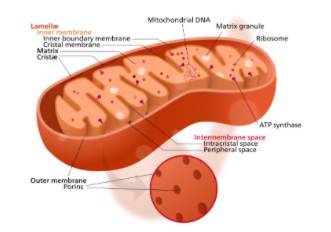
Define cristae of a mitochondria.
Answer
584.1k+ views
Hint: A crista is a fold in the inner membrane of a mitochondrion. It has a characteristic wrinkled shape that provides a large surface area for chemical reactions to occur.
Complete answer:

Mitochondria is double membranous cell organelle. It generates the chemical energy needed for the cell's biochemical reactions. Mitochondria is called the powerhouse of the cell. Chemical energy is produced by the mitochondria in the form of a molecule called adenosine triphosphate (ATP). Mitochondria is semi-autonomous because it contains DNA.
Mitochondrial membrane function is to produce energy. This produced energy is transferred to different cellular pathways i.e. it is convertible. The result of this conversion is ATP. The phosphate in ATP provides a high-energy bond that acts as an energy source for reactions within the cell. Upon energy need, different cells have different amounts of mitochondria. So, for example, the muscle has a lot of mitochondria. Mitochondria are exclusively found in the eukaryotic cell. It measures between 0.75 and 3 μm² in area.
A mitochondrion has double membranes that divide mitochondria into five distinct parts. They are:
> the outer mitochondrial membrane
> the intermembrane spaces
> the inner mitochondrial membrane
> the cristae space
> the matrix
Cristae
Cristae is the compartment in the inner mitochondrial membrane that expands the surface area of the inner mitochondrial membrane, enhancing its ability to produce ATP. Cristae are studded with F1 particles or oxysomes. Cristae are invaginations of the inner membrane that perform the chemiosmotic function.
Note: The cristae greatly increase the surface area of the inner membrane on which the above-mentioned reactions may take place. Cristae are invaginations of the inner membrane that perform the chemiosmotic function. Examples of Cristae Disorders are amyotrophic lateral sclerosis (ALS) disease, Alzheimer’s disease and Parkinson’s disease.
Complete answer:

Mitochondria is double membranous cell organelle. It generates the chemical energy needed for the cell's biochemical reactions. Mitochondria is called the powerhouse of the cell. Chemical energy is produced by the mitochondria in the form of a molecule called adenosine triphosphate (ATP). Mitochondria is semi-autonomous because it contains DNA.
Mitochondrial membrane function is to produce energy. This produced energy is transferred to different cellular pathways i.e. it is convertible. The result of this conversion is ATP. The phosphate in ATP provides a high-energy bond that acts as an energy source for reactions within the cell. Upon energy need, different cells have different amounts of mitochondria. So, for example, the muscle has a lot of mitochondria. Mitochondria are exclusively found in the eukaryotic cell. It measures between 0.75 and 3 μm² in area.
A mitochondrion has double membranes that divide mitochondria into five distinct parts. They are:
> the outer mitochondrial membrane
> the intermembrane spaces
> the inner mitochondrial membrane
> the cristae space
> the matrix
Cristae
Cristae is the compartment in the inner mitochondrial membrane that expands the surface area of the inner mitochondrial membrane, enhancing its ability to produce ATP. Cristae are studded with F1 particles or oxysomes. Cristae are invaginations of the inner membrane that perform the chemiosmotic function.
Note: The cristae greatly increase the surface area of the inner membrane on which the above-mentioned reactions may take place. Cristae are invaginations of the inner membrane that perform the chemiosmotic function. Examples of Cristae Disorders are amyotrophic lateral sclerosis (ALS) disease, Alzheimer’s disease and Parkinson’s disease.
Recently Updated Pages
Master Class 12 Business Studies: Engaging Questions & Answers for Success

Master Class 12 Economics: Engaging Questions & Answers for Success

Master Class 12 English: Engaging Questions & Answers for Success

Master Class 12 Maths: Engaging Questions & Answers for Success

Master Class 12 Social Science: Engaging Questions & Answers for Success

Master Class 12 Chemistry: Engaging Questions & Answers for Success

Trending doubts
Which places in India experience sunrise first and class 9 social science CBSE

Fill the blanks with the suitable prepositions 1 The class 9 english CBSE

Write the 6 fundamental rights of India and explain in detail

Difference Between Plant Cell and Animal Cell

What is the Full Form of ISI and RAW

Golden Revolution is related to AFood production BOil class 9 social science CBSE




